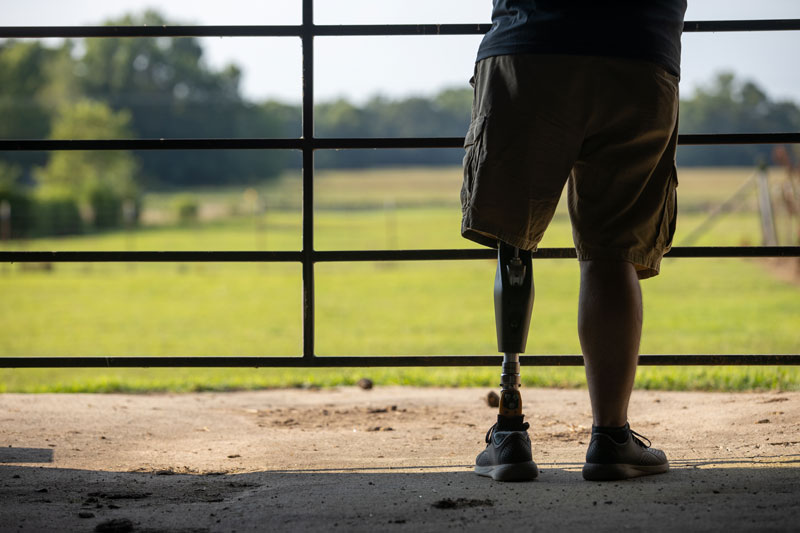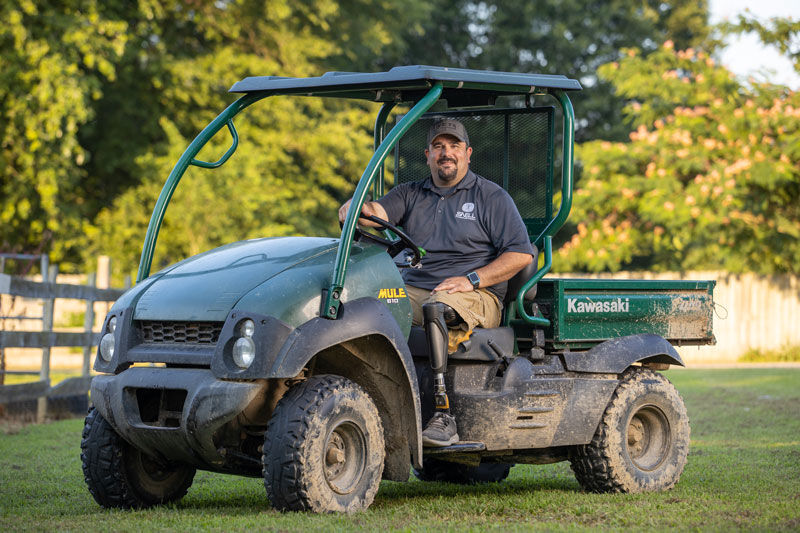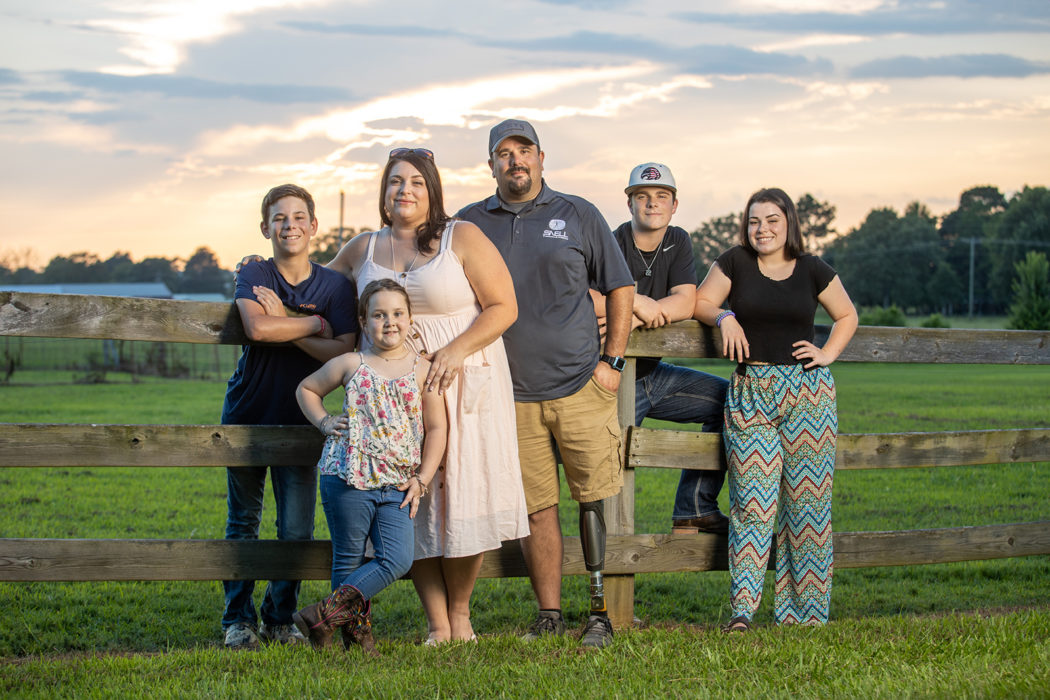On Monday, August 23rd of 2004, Brandon Whitfield felt his life moving in the right direction. He and his wife had a healthy eleven-month-old son with a second child on the way. He’d just started working at a great job, and was headed back to his hotel to make his nightly phone call to his young family.
Around 7:30 p.m., he’d hopped in his vehicle and headed down off of Mt. Magazine, where he and other superintendents had just finished a long week of overtime and meetings.
It all happened in less than a minute.
Brandon noticed a truck, with a pipe fastened to the front as a makeshift deer guard, rolling up to a stop sign. Brandon had the right of way, but he slowed slightly to make sure the other driver intended to stop. When Brandon saw the other truck slowing, he let off the brakes and continued. As Brandon neared, the other driver suddenly sped across the road, accelerating into the driver’s side of Brandon’s vehicle.
Brandon spun seven or eight times, and the vehicle stopped upright. The realizations came to him one after the other. He was alive. He needed to get out of the vehicle. He tried to get out of the drivers-side door, but the other driver’s makeshift deer guard pinned the door shut. When Brandon tried to move towards the passenger-side door, he realized his leg was not moving with him. He was hurt—badly.
“I knew it was bad because I’d seen stuff like this before since I was a first responder with the Runyan Acres Volunteer Fire Department,” said Brandon. “Guys were climbing in and out of the car trying to start IVs because I was losing blood. I was in there for almost an hour. MedFlight was called. They didn’t think I’d make it.”
Thousands of thoughts flashed through Brandon’s mind while they worked to get him out of the vehicle. His main objective? Convince MedFlight to fly him to a Little Rock hospital instead of Fort Smith. Even though Little Rock was further from the scene of the accident, it would get him closer to his family. He wanted to tell his wife and son he loved them.
“I finally talked the MedFlight drivers into taking me to Little Rock. The whole time, through all that mess, I never lost consciousness until I saw my wife.”
After arriving at the hospital, the rest is a blur for Brandon. He was in and out of consciousness for the following week and has little to no memory of the time.
The doctor’s initially planned to amputate his leg because of the severity of the injury. He’d lose the left knee joint and the tip of the femur. Then, a trauma surgeon at UAMS named Dr. Johannes Gruenwald heard of the accident. He reviewed Brandon’s case and thought there was a possibility he could save Brandon’s leg.
This led to a journey through a dozen different surgeries in less than two years.
 “After the accident, I was in and out of the hospital constantly. About every two months, something crazy would happen. I would spike a 104-degree fever. They’d rush me to the ER.
“After the accident, I was in and out of the hospital constantly. About every two months, something crazy would happen. I would spike a 104-degree fever. They’d rush me to the ER.
“It got to the point where they couldn’t get the infection under control. I had to take antibiotics by PICC line twice a day for a year. That’s something my wife had to do on top of having two kids under 2 years old. It was a crazy time.”
It slowly became clear Brandon’s leg wasn’t healing. Dr. Gruenwald recommended he get a second opinion.
Brandon reached out to a family friend, Dr. Siems. During the appointment, Dr. Siems had a few recommendations for continued treatment, like spending several hours in the hyperbaric chamber three or four times a week. But Dr. Siems was honest with Brandon, telling him he was doubtful that any treatments would achieve much mobility for him.
“When I got home that evening I just looked at my wife, Sarah. I said, ‘I’m done. I’ve done everything that I could possibly do to try to save it.’ Because at that point, the best-case scenario is I would have about 15 degrees of flexion and hardly any extension. I would basically have a peg leg at 25, 26 years old.”
Despite being sure he was ready to take the next step, the decision came with a lot of unknowns. Brandon was unemployed, ineligible for workman’s comp, and didn’t even know what life as an amputee would look like.
So, he set an appointment to talk to Frank Snell, CPO, LPO, FAAOP, owner of Snell Prosthetics & Orthotics, and prosthetist at the Little Rock location. They introduced themselves and dove into talking about prosthetic technology and how Frank recommended they move forward.
“I kind of stopped him and said, ‘Frank, the thing is, I can’t pay for this.’ And Frank flat out told me, and I’ll never forget this, he said ‘Don’t you worry about the money. Let’s get your life back. We’ll figure out the rest later.’ From then on, me and Frank’s friendship blossomed.”
With newfound resolve after meeting with Frank, and after hearing Dr. Siem’s opinion, Brandon scheduled an appointment with Dr. Gruenwald.
“I crutched in there and the only words I had in my mouth were ‘cut it off.’ He shook my hand and said, ‘About time you made that decision.’ And we scheduled my surgery.”
After his surgery, an above-the-knee amputation of the left leg, there was one person Brandon wanted to see.
“I didn’t want anyone crying or saying ‘poor, pitiful Brandon’ or any of that stuff. I just want to see my dad. He’s one of the big reasons why I’m as strong as I am,” said Brandon, “because he pushed me further past limits I thought I had.”
Brandon’s first appointment to be fitted for a prosthetic leg was an emotional one. Frank walked in and said ‘Are you ready to take a walk with me?’ Life opened up in every way from that day forward.
Brandon assumed the posture of a man on a mission. The recommended rest and recovery time did not mean much to him, and he threw himself into the process of adjusting to his new reality.
“I was what we call ‘non-compliant’. I did not follow instructions. Everybody wanted me to go slow. I wanted to go fast.”
He blew through therapy. Doing the prescribed amount of exercise repetitions wasn’t satisfying him. He’d go home after therapy and do everything 15 more times.
He began walking. He walked with two crutches. Quickly he went to one crutch, and then to a cane. After a couple of months, Brandon was walking without using any type of assistive device.
The Snell team built his prosthesis, so Brandon was no stranger to the office. Because of his age and agility, Brandon was also the perfect candidate to try out new things.
“Frank and I really had a very good relationship from the start. I’ve always been good at talking to people, so I went to a lot of classes and seminars with Frank. I would wear Microprocessor B and we’d go talk to students or nurses or PTs, and teach them about new prosthetics and the advances in technology.“
Frank could tell Brandon had a knack for the field. In 2011, Frank came to Brandon with a suggestion. He asked Brandon to consider coming on board and working at Snell.
”I had no medical experience. I was either farming or on a construction site or side job with my dad helping him build something nearly my whole life,” said Brandon. “At that time, I could never picture myself in anything but construction.”
The next year, Frank again asked Brandon if he’d be willing to meet about seriously exploring the idea of working alongside him at Snell. The two met, and Brandon told him he’d try it out for a couple of weeks.
“I absolutely fell in love with it. It was just the best thing. I started as a technician, so I built everything—braces, insoles, prosthetic legs. It went from there to getting my assistant license.
“Now, I’m a licensed prosthetist orthotist assistant and the office manager for the Snell Prosthetics & Orthotics location in Conway.
“I want patients to have a chance to see hope through me. Whenever I walk into a hospital room or exam room, a lot of times you cannot tell I’m an amputee.
“I’ll talk to the patient about prosthetics, and then I’ll reveal to them that I’m an amputee. And their first response is ‘Really? But you can walk, and work, and hunt, and fish, and do all the stuff you want to do?’ And I get to tell them ‘Yes!’
“I can tell you exactly what it’s like to be an amputee. There is no guessing. I haven’t read it in a book. I haven’t just researched it. I’ve lived it. And I’ve always used this as a platform.
“It’s important to me to be active in the amputee community. With this platform, and even with my kids, I want them to see even when they struggle, because everybody will struggle, we don’t lay down. That was what pushed me a lot of the times when I just had nothing to go on.”





